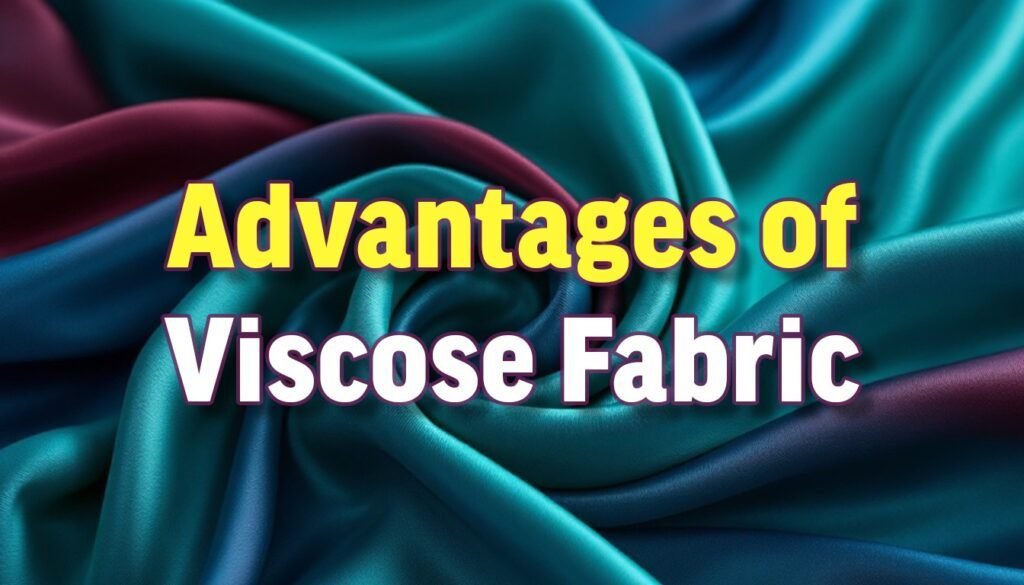When shopping for clothes, upholstery, or home textiles, you may have come across viscose fabric. Known for its softness, breathability, and affordability, viscose has become a go-to material in the fashion and textile industry. Whether you’re looking for a cooling summer fabric, a silk alternative, or vibrant printed outfits, viscose offers several benefits.

In this guide, we’ll dive deep into the advantages of viscose fabric, compare it to other materials, and explore its many uses. If you’re wondering whether viscose is the right choice for you, keep reading!
What is Viscose Fabric?
Viscose is a semi-synthetic fabric made from natural wood pulp, typically sourced from trees like beech, eucalyptus, or bamboo. The raw cellulose from these trees undergoes a chemical process to create soft, breathable fibers that mimic the luxurious feel of silk.
How is Viscose Made?
The production process of viscose includes several steps:
- Extraction of Cellulose – Wood pulp is collected from natural sources.
- Chemical Treatment – The pulp is dissolved in chemicals (like sodium hydroxide) to create a viscous solution.
- Spinning the Fibers – The liquid solution is forced through tiny holes to form fibers.
- Solidification and Weaving – The fibers are treated and woven into fabric.
This process results in a fabric that feels natural and comfortable while being more affordable than cotton or silk.
Also Read Trending Post
- 20 High Protein Meal Prep Ideas for Weight Loss, Muscle Gain & Busy Lifestyles (2025 Guide)
- Healthy and Sustainable Rooftop Gardening Guide for Beginners: Simple and Effective Methods
- Eco-Friendly Meal Prep Ideas: 10 Essential Tips for Healthy and Sustainable Eating
- Microplastics: Invisible Danger in Our Food, Water, and Environment
- Top 25 Plant-Based Protein Sources Chart: Your Ultimate Visual Guide for a Healthier Diet!
The Characteristics of Viscose Fabric
Viscose fabric stands out due to its unique properties, making it a popular choice for fashion designers and manufacturers. Some of its defining characteristics include:
- Silky Texture – Feels soft and smooth, like silk or high-quality cotton.
- Breathability – Allows air circulation, preventing sweat buildup.
- Moisture Absorption – Wicks away sweat, keeping you cool.
- Lightweight and Draping – Flows elegantly on the body.
- Excellent Dye Retention – Produces vibrant colors and bold prints.
- Versatility – Easily blended with other fabrics for durability.
These features make viscose a favorite fabric for summer wear, elegant evening dresses, and even upholstery.
Soft and Comfortable
Why Does Viscose Feel So Soft?
Viscose is remarkably soft due to its natural cellulose fibers. Unlike polyester, which can feel rough or synthetic, viscose provides a gentle touch on the skin, making it an excellent choice for:
- Casual wear like T-shirts and pajamas
- Luxury dresses that require a silky feel
- Bedding and upholstery for comfort
How Does Viscose Compare to Other Fabrics?
| Fabric | Softness Level | Texture |
|---|---|---|
| Viscose | Very soft | Smooth, flowy |
| Cotton | Soft | Slightly textured |
| Polyester | Less soft | Can feel synthetic |
| Silk | Ultra-soft | Silky, luxurious |
Viscose fabric offers the best of both worlds—it feels like silk but is as breathable as cotton, making it a top choice for comfort seekers.
Breathable and Cool
Why is Viscose Great for Hot Weather?
One of the biggest advantages of viscose fabric is its breathability. Unlike synthetic fabrics that trap heat and moisture, viscose allows air to circulate, helping to:
✅ Regulate body temperature – Keeps you cool in summer.
✅ Prevent sweat buildup – Absorbs moisture and dries quickly.
✅ Feel light on the skin – Ideal for tropical climates.
Viscose Fabric for Summer: The Ideal Choice
If you live in warm or humid regions, choosing the right fabric is essential. Viscose is designed for comfort in hot weather, making it perfect for:
- Summer dresses and tops – Keeps you fresh all day.
- Breathable scarves and hijabs – Light and airy.
- Soft sleepwear – Keeps you sweat-free at night.
Does Viscose Absorb Sweat?
Yes! Unlike polyester, which repels moisture, viscose absorbs up to 50% of its weight in water without feeling damp. This moisture-wicking ability makes it a top choice for activewear and warm-weather outfits.
Lightweight and Flowing
Why Does Viscose Drape So Well?
Advantages of Viscose Fabric has a natural fluidity, which allows it to fall gracefully around the body. Unlike stiff or rigid fabrics, it creates:
- Effortless movement in dresses and skirts.
- A flattering silhouette for all body types.
- Elegant, flowy designs for evening wear.
Who Loves Viscose? Fashion Designers!
Fashion designers prefer viscose because it is:
✔️ Easy to shape into stylish designs.
✔️ Soft yet structured, making it adaptable.
✔️ Ideal for layering, as it doesn’t feel bulky.
Viscose in Everyday Clothing
Because of its lightweight nature, viscose is a popular choice for:
- Maxi dresses that sway with movement.
- Boho blouses with elegant draping.
- Chic summer pants that feel weightless.
If you love effortless fashion, viscose fabric is your go-to choice!
Affordable Alternative to Silk
Silk is known for its luxury, smoothness, and high cost, but viscose mimics silk’s texture at a fraction of the price.
Silk vs. Viscose: What’s the Difference?
| Feature | Silk | Viscose |
|---|---|---|
| Price | Expensive | Affordable |
| Softness | Ultra-soft | Very soft |
| Durability | Delicate | More durable |
| Maintenance | High care | Low maintenance |
Why Choose Viscose Over Silk?
1️⃣ Budget-Friendly – You get a luxurious feel without spending a fortune.
2️⃣ Easier Care – Unlike silk, viscose is easier to wash and maintain.
3️⃣ Greater Availability – Found in everyday fashion stores.
If you love the glamorous look of silk but don’t want the hassle of delicate maintenance, viscose is the best alternative.
Versatile and Easily Blended
Why is Viscose So Versatile?
Viscose is one of the most adaptable fabrics, often blended with other fibers to enhance its properties. Since it has a soft and breathable nature, combining it with other materials can improve durability, stretch, or wrinkle resistance.
Popular Viscose Blends and Their Benefits
| Blend | Why It’s Used | Common Uses |
|---|---|---|
| Viscose + Cotton | Enhances softness and absorbency | T-shirts, casual dresses |
| Viscose + Polyester | Adds durability and reduces wrinkles | Workwear, suits, upholstery |
| Viscose + Spandex | Improves elasticity and comfort | Leggings, activewear, fitted dresses |
Viscose Upholstery Fabric Pros and Cons
Not just for clothing, viscose is also used in upholstery fabrics. Here are the pros and cons:
✅ Pros
- Soft and comfortable for furniture
- Absorbs dyes well for vibrant colors
- Blends well with cotton and polyester for durability
❌ Cons
- Can wrinkle easily if not blended
- Absorbs moisture, which may cause staining
- Requires proper care to maintain longevity
Despite some drawbacks, viscose upholstery fabric remains a budget-friendly and stylish option for sofas, chairs, and curtains.

Vibrant Colors and Prints
How Well Does Viscose Absorb Dye?
One of the biggest advantages of viscose fabric is its ability to absorb and retain dyes exceptionally well. Unlike polyester, which can sometimes look dull, viscose fibers soak up colors deeply, creating rich, vibrant hues.
Benefits of Viscose in Printed Fabrics
- Holds bold, eye-catching colors
- Doesn’t fade easily if properly cared for
- Ideal for floral prints, abstract designs, and ethnic patterns
This makes viscose an excellent choice for statement pieces, including:
✔️ Bohemian maxi dresses
✔️ Ethnic scarves and sarongs
✔️ Brightly patterned blouses
Whether you love bold prints or solid vibrant colors, viscose ensures your outfits always stand out!
Eco-Friendlier Than Synthetic Fabrics
Is Viscose Sustainable?
Viscose is considered more eco-friendly than fully synthetic fabrics like polyester or nylon because:
- It’s made from renewable wood pulp (natural origins).
- It is biodegradable, unlike plastic-based fibers.
- It requires fewer fossil fuels compared to polyester production.
Concerns About Viscose Production
However, there are some concerns regarding viscose production:
❌ Chemical Processing – Harsh chemicals are used in manufacturing.
❌ Deforestation Risks – Large-scale production may lead to deforestation.
Many manufacturers are now opting for sustainable viscose, such as EcoVero™ viscose, which ensures responsible sourcing and minimal environmental impact.
Viscose vs. Polyester: Which is More Eco-Friendly?
| Feature | Viscose | Polyester |
|---|---|---|
| Source | Wood pulp (natural) | Petroleum-based (synthetic) |
| Biodegradable? | Yes | No |
| Microplastics? | No | Yes |
| Energy-Intensive? | Moderate | High |
Winner? Viscose is the better choice for sustainability!
Viscose vs. Cotton: Which is Better for Summer?
When it comes to summer fabrics, both viscose and cotton are excellent choices, but they have distinct differences.
Comparing Their Cooling Properties
| Feature | Viscose | Cotton |
|---|---|---|
| Breathability | High | High |
| Moisture-Wicking | Excellent | Good |
| Softness | Silky smooth | Soft but textured |
| Weight | Lightweight | Varies (depends on weave) |
| Durability | Moderate | High |
Which One Should You Choose?
- Choose Viscose if you want a lightweight, flowy fabric that drapes elegantly.
- Choose Cotton if you prefer natural durability and texture.
Both are great for summer, but viscose fabric for summer offers an extra touch of elegance and cooling properties.
Viscose vs. Polyester: How Do They Differ in Feel and Durability?
While viscose and polyester look similar, they have significant differences in comfort, breathability, and durability.
Side-by-Side Comparison
| Feature | Viscose | Polyester |
|---|---|---|
| Softness | Very soft | Less soft |
| Breathability | High | Low |
| Durability | Moderate | Very high |
| Wrinkle Resistance | Low | High |
| Moisture-Wicking | High | Low |
| Eco-Friendliness | Better | Worse |
Pros and Cons of Each Fabric
✅ Viscose Pros
✔️ Soft, breathable, and moisture-wicking
✔️ Feels more natural against the skin
✔️ Absorbs dyes well for vibrant colors
❌ Viscose Cons
❌ Less durable than polyester
❌ Prone to shrinking if not washed properly
✅ Polyester Pros
✔️ Highly durable and wrinkle-resistant
✔️ Quick-drying and low maintenance
✔️ Often cheaper to produce
❌ Polyester Cons
❌ Less breathable (can trap heat and sweat)
❌ Feels synthetic and can cause skin irritation
Which One Should You Choose?
- For comfort and breathability? ✅ Viscose
- For durability and easy care? ✅ Polyester
- For an elegant, luxurious feel? ✅ Viscose
If you prioritize style, softness, and comfort, viscose fabric is the clear winner.

Conclusion
Viscose fabric is an exceptional choice for those seeking comfort, breathability, and affordability. With its silky texture, lightweight nature, and cooling properties, it is ideal for summer wear, elegant drapes, and even upholstery.
✔️ Soft and luxurious, like silk but much more affordable
✔️ Breathable and moisture-wicking, perfect for summer
✔️ Lightweight and flowing, giving outfits a stylish drape
✔️ Versatile and blends well with other fabrics
✔️ Eco-friendlier than synthetic fibers, making it a better alternative to polyester
Whether you’re looking for everyday casual wear, statement fashion pieces, or comfortable upholstery, viscose remains a popular and practical choice!
FAQs: Advantages of Viscose Fabric
1. Is viscose fabric good for summer?
Yes! Viscose fabric for summer is perfect because it is lightweight, breathable, and moisture-wicking, keeping you cool and fresh.
2. Is viscose better than cotton?
It depends on your needs. Viscose is softer and drapes better, while cotton is more durable and easier to maintain.
3. Does viscose shrink in the wash?
Yes, if washed improperly. It’s best to hand wash in cold water or use a gentle cycle to prevent shrinking.
4. Is viscose good for upholstery?
Yes, but it is often blended with polyester or cotton to enhance durability. Viscose upholstery fabric pros and cons should be considered before choosing it.
5. What is the price of viscose fabric?
The viscose fabric price varies depending on quality, brand, and blend, but it is generally more affordable than silk and cotton.












I just couldn’t leave your site prior to suggesting that I really enjoyed the usual information an individual provide on your visitors? Is gonna be back ceaselessly in order to investigate cross-check new posts.
Your comment is awaiting moderation.